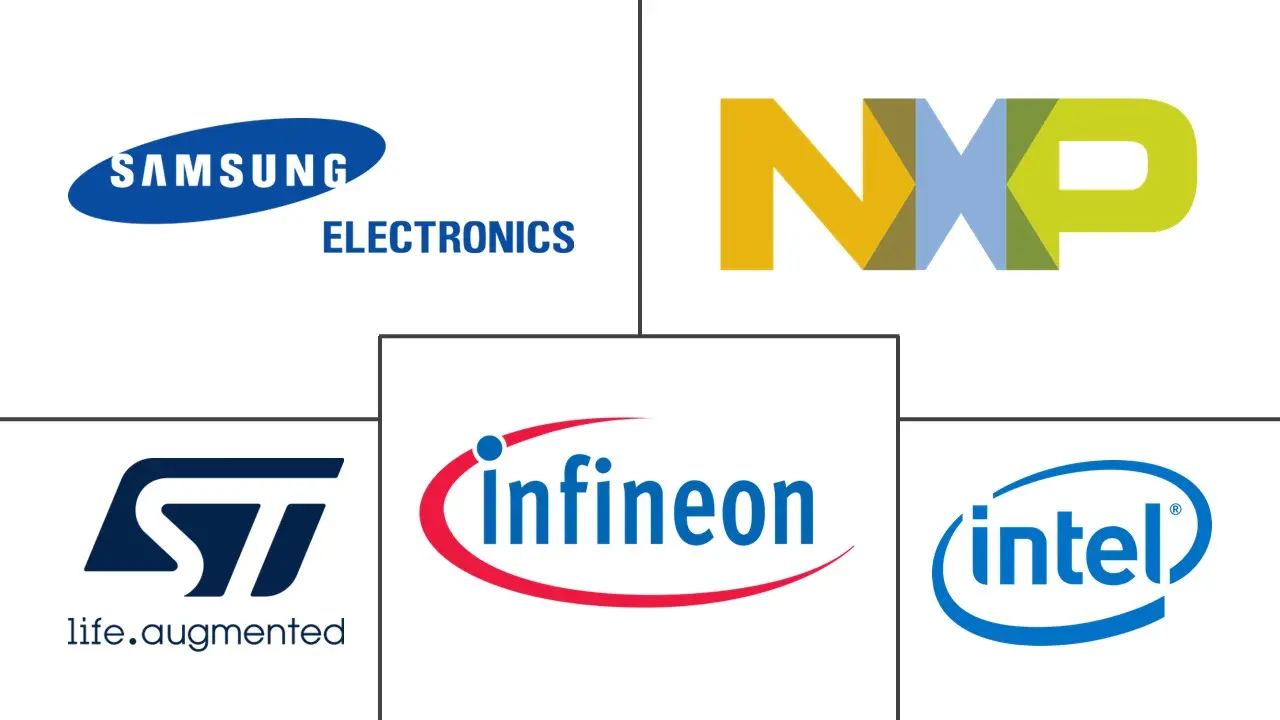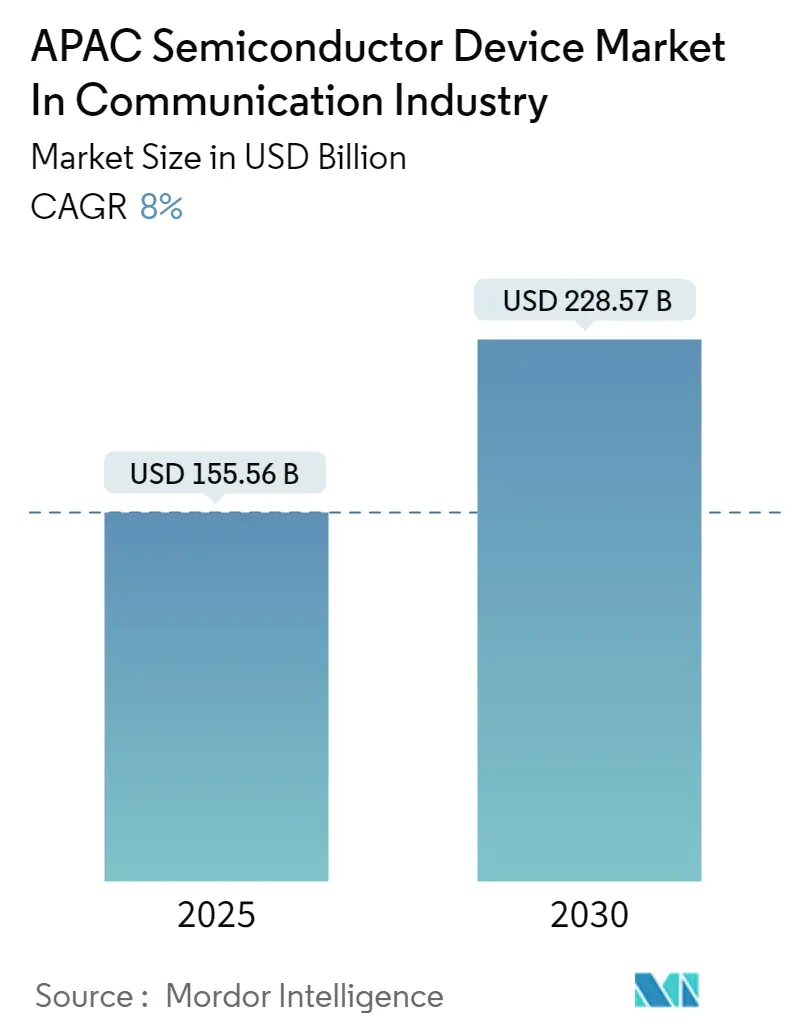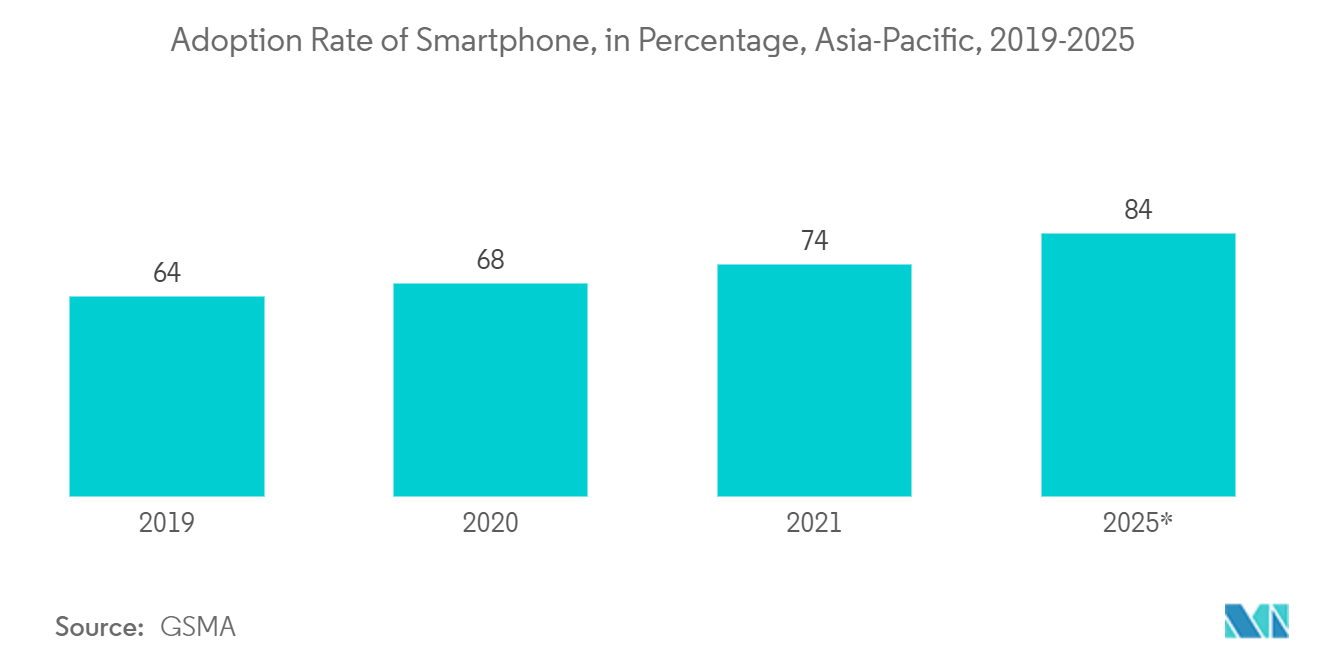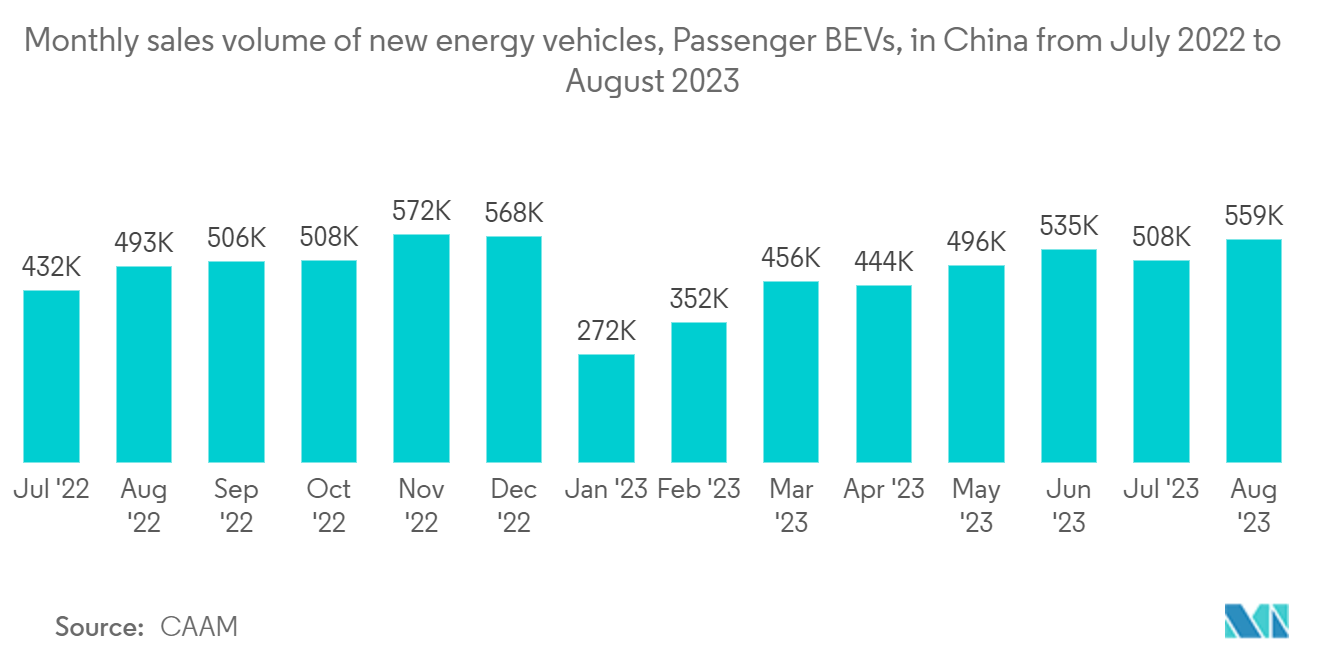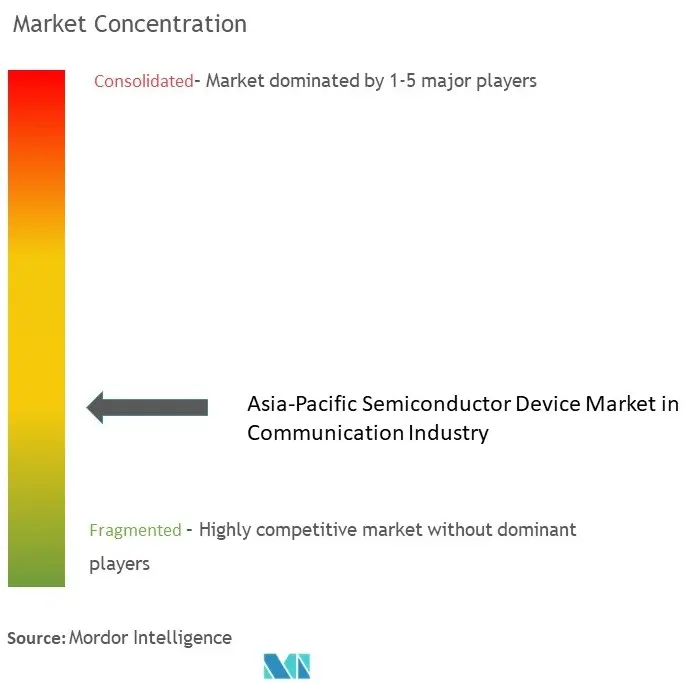APAC Semiconductor Device Market Analysis
The APAC Semiconductor Device Market In Communication Industry is expected to grow from USD 155.56 billion in 2025 to USD 228.57 billion by 2030, at a CAGR of 8% during the forecast period (2025-2030).
- The semiconductor industry is evaluated to continue its robust growth during the forecast period to accommodate the increasing need for semiconductor materials in rising technologies, such as artificial intelligence, autonomous driving, the Internet of Things (IoT), and 5G, coupled with competition among significant players and constant spending on R&D driving the market growth.
- Most critical elements of modern telecommunication are built from semiconductor devices like MOSFETs, including mobile devices, base station modules, transceivers, routers, microprocessors, RF power amplifiers, memory chips, and telecommunication circuits.
- In addition, network and communication chips are semiconductor integrated circuits (ICs) utilized in telecommunication gadgets and systems. Network and communication chips operate in many different technologies. Further, in June 2022, India carried on Chippagedon (the international chip shortage crisis) and aimed to bring semiconductor and display fab manufacturing to the country in the coming years.
- Other PLI schemes are looking to accelerate domestic manufacturing of telecom and networking products. The supply chain and the logistics sector will play a vital role in meeting raw material demands for Indian manufacturers. In addition, 'Make in India' is an initiative by the Government of India to make and encourage companies to develop, manufacture and build products made in India and incentivize dedicated investments into manufacturing that may create effective demand in the studied market.
- The increasing demand for data centers also boosts the demand for memory components. Large data center projects in the Asia Pacific contributed to the vital need for memory, such as DRAM. However, according to the standard of data-center space per user, China's internet data centers are balanced to at least 22 times that of the United States or at least ten times the current area of Japan. Hence, DRAM has a significant opportunity for growth and thus is impacting the semiconductor industry.
- Furthermore, the rising proliferation of smartphones, feature tablets, and phones drives the studied market. Analog ICs are used in various applications, including third and fourth-generation (3G/4G) radio base stations and portable instrument batteries. RFICs are analog circuits that usually run in the frequency range of 3kHz to 2.4GHz (3000 hertz to 2.4bn hertz) circuits that work at about 1 THz (1tn hertz). They are widely utilized in cell phones and wireless devices. Due to such development, the analog IC demand in this communication industry may grow further.
- Mobile internet penetration for the region is expected to escalate from 44% recently to 52% in 2025. This evolution is attributable to the anticipated surge in the number of mobile internet users in the region. Furthermore, the GSMA report indicates a significant jump of not less than 200 million latest sim connections from 2021 to 2025 in the region. This results in the sim card penetration rate from 100% to 105% in 2025.
- Moreover, the ongoing semiconductor supply crunch could disrupt inventories for producing smartphones, routers, and IoT devices, impacting telecom operators' sales and service revenues.
APAC Semiconductor Device Market Trends
Wireless Communication Technology is Expected to Drive the Market Growth
- Semiconductors for wireless communications include cellular baseband processors, Bluetooth transceivers, mobile Wi-Fi chips, global positioning system (GPS) receivers, and near-field communication chips.
- The Asia-Pacific market is expected to witness significant growth in wireless connectivity systems. For instance, according to the U.S.-China Economic and Security Review Commission, government investment in smart city initiatives in China would achieve USD 38.92 billion in the current year. The development of smart infrastructure is anticipated to open unique avenues for wireless connectivity techniques.
- Additionally, the expansion of 5G networks in the region is predicted to be one of the significant factors driving the market growth. According to the GSMA's latest report, 5G is anticipated to contribute about USD 960bn to the designed economies of East Asia and the Pacific by 2030. 5G is predicted to be a significant driving force in automatic smart factory deployments in the region.
- According to GSMA, the adoption rate of smartphones in the region is projected to increase to 84% by 2025. In addition, it is anticipated that 62% of mobile subscribers will be present in the same year. Encouragingly, the smartphone adoption rate for this region is expected to be 20% between 2019 to 2025.
- Further, wireless technology advancement saturates many areas of lives and continues to expand. For example, individuals expect instant access to maps on mobile devices and in-flight Wi-Fi during travel. In the medical field, "digital plasters" monitor and transmit patient vital signs. Wireless sensors are even being used to monitor carbon transfer in the Costa Rican rainforest. The multiple familiar wireless application is the mobile phone, where smartphones drive market growth. For instance, in February 2022, Verizon announced the expansion of its Internet service by allowing it to access reliable, fast plug-and-play wireless Internet services around the country, covering over 30mn homes and more than 2mn businesses.
- The Apple A16 Bionic, a 64-bit ARM-based SoC that first appeared in the iPhone 14Pro, launched on September 2022. The A16 has 16bn transistors and is built on TSMC's N4 fabrication procedure, being touted by Apple as a smartphone's first 4 nm processor.
China to Experience Significant Market Growth
- China has a significant population in the world and is one of the topmost technologically developed countries globally. China's rapid technological advancements are directing the demand for innovative IT devices. China leads the pack in various areas, such as artificial intelligence (AI), telephone device making, 5G telecommunication networks, and many others. According to China Telecom, in 2022, China Telecom generated a revenue of around CNY 475 billion (USD 65.40 billion), a significant increase from CNY 440 billion (USD 60.58 billion) in the previous year.
- The country is investing significantly in the studied market growth. It is anticipated that 5G will gradually alter how people use their phones. It has also emerged as a prominent participant in the smartphone sector. Across the country, the demand and shipments of 5G-capable smartphones have drastically increased during the last few quarters.
- According to MIIT, the number of 5G base stations in China amounted to 2.31 million by the end of 2022. The country is rapidly expanding its 5G infrastructure. According to forecasts, 5G base stations were projected to achieve over six million by 2024. Huawei was the significant company in this industry, followed by ZTE.
- In addition, according to GSMA, 5G connections in the country are expected to reach 460 million by 2025, making up 28% of all national connections. The Chinese market was expected to surpass the combined size of commercial 5G services in Australia, South Korea, the United States, and the UK, with a predicted average yearly growth rate of 63%. Such 5G deployment in the country may further drive the studied market growth.
- Increasing investments in data centers in the country may further drive the studied market growth. For instance, in February 2023, CapitaLand Investment Limited announced it had established CapitaLand China Data Centre Partners (CDCP), creating two hyperscale data centers in Greater Beijing. The two development projects are expected to be completed in 2025 and deliver more than 100MW. In addition, in February 2022, China approved ten national-data center groups for greater computing power nationwide.
- Furthermore, in April 2023, China's southern Guangdong province intends to launch a second phase of a semiconductor fund with a scale of USD 4.37 billion. The fund will have a duration of 17 years and will invest in auto chips and equipment for semiconductor fabric. This may further drive the studied market growth in the forecasted period.
APAC Semiconductor Device Industry Overview
Asia-Pacific Semiconductor Device Market in Communication Industry fluctuates with growing mergers, technological advancements, and geopolitical scenarios. The Market is favorably competitive, with several players. The market space remains highly contested due to the economies of scale and nature of the product offerings, and the cost-volume metrics favor companies that operate with low-fixed costs. Some key players in the Market are Samsung Electronics Co. Ltd, Intel Corporation, and NXP Semiconductors NV, among others. Some key recent developments in the Market include:
- August 2022: Qualcomm Technologies Inc. introduced its flagship Snapdragon 8+ Gen 1 mobile platform, powering Samsung Electronics Co. Ltd's most delinquent foldable smartphones, the Samsung Galaxy Z Fold4 and Galaxy Z Flip4. Samsung and Qualcomm collaborate to define the next generation of premium Android experiences.
- July 2022: Ericsson, Qualcomm Technologies Inc., and French aerospace company Thales planned to take 5G out of this world and across a network of Earth-orbiting satellites. After conducting detailed research, including multiple studies and simulations, the parties plan to enter smartphone-use-case-focused testing and validate 5G non-terrestrial networks (5G NTN).
APAC Semiconductor Device Market Leaders
-
Samsung Electronics Co. Ltd
-
Intel Corporation
-
NXP Semiconductors NV
-
Infineon Technologies AG
-
STMicroelectronics NV
- *Disclaimer: Major Players sorted in no particular order
APAC Semiconductor Device Market News
- March 2023: Polymatech Electronics, a semiconductor chip manufacturer, intends to mass-produce advanced semiconductor components in India for 5G and 6G applications. Currently under testing, Polymatech will begin manufacturing chips at the company's main manufacturing plant in Kancheepuram, Tamil Nadu.
- January 2022: Telstra introduced the deployment of Ericsson Private 5G, an on-premise dedicated 5G network for enterprises that operates a single-server 5G dual-mode core. Telstra's avant network capabilities offer an industrial wireless connectivity platform for the business that can provide low latency and enhanced resiliency.
APAC Semiconductor Device Industry Segmentation
A semiconductor device is an electronic element that depends on the electronic properties of a semiconductor material for its function. Semiconductor devices used in wired and wireless communications include Ethernet controllers, adapters, switches, mobile Wi-Fi chips, GPS receivers, near-field communication chips, and among others. The impact of COVID-19 on the market and impacted applications are also covered under the scope of the study. Further, the disturbance of the elements affecting the market's evolution in the near future has been covered in the study regarding drivers and restraints.
Asia-Pacific semiconductor device market in communication industry is segmented by device type (discrete semiconductors, optoelectronics, sensors, integrated circuits [analog, logic, memory, micro [microprocessors (MPU), microcontrollers (MCU), digital signal processors]], and by country (China, India, Japan, South Korea and Rest of the Asia Pacific). The report offers market forecasts and size in value (USD) for all the above segments.
| By Device Type | Discrete Semiconductors | |||
| Optoelectronics | ||||
| Sensors | ||||
| Integrated Circuits | Analog | |||
| Logic | ||||
| Memory | ||||
| Micro | Microprocessors (MPU) | |||
| Microcontrollers (MCU) | ||||
| Digital Signal Processors | ||||
| By Country | China | |||
| Japan | ||||
| India | ||||
| South Korea | ||||
APAC Semiconductor Device Market In Communication Industry Market Research Faqs
How big is the APAC Semiconductor Device Market In Communication Industry?
The APAC Semiconductor Device Market In Communication Industry size is expected to reach USD 155.56 billion in 2025 and grow at a CAGR of 8% to reach USD 228.57 billion by 2030.
What is the current APAC Semiconductor Device Market In Communication Industry size?
In 2025, the APAC Semiconductor Device Market In Communication Industry size is expected to reach USD 155.56 billion.
Who are the key players in APAC Semiconductor Device Market In Communication Industry?
Samsung Electronics Co. Ltd, Intel Corporation, NXP Semiconductors NV, Infineon Technologies AG and STMicroelectronics NV are the major companies operating in the APAC Semiconductor Device Market In Communication Industry.
What years does this APAC Semiconductor Device Market In Communication Industry cover, and what was the market size in 2024?
In 2024, the APAC Semiconductor Device Market In Communication Industry size was estimated at USD 143.12 billion. The report covers the APAC Semiconductor Device Market In Communication Industry historical market size for years: 2019, 2020, 2021, 2022, 2023 and 2024. The report also forecasts the APAC Semiconductor Device Market In Communication Industry size for years: 2025, 2026, 2027, 2028, 2029 and 2030.
Our Best Selling Reports
APAC Semiconductor Device Market In Communication Industry Industry Report
Statistics for the 2025 APAC Semiconductor Device In Communication Industry market share, size and revenue growth rate, created by Mordor Intelligence™ Industry Reports. APAC Semiconductor Device In Communication Industry analysis includes a market forecast outlook for 2025 to 2030 and historical overview. Get a sample of this industry analysis as a free report PDF download.

